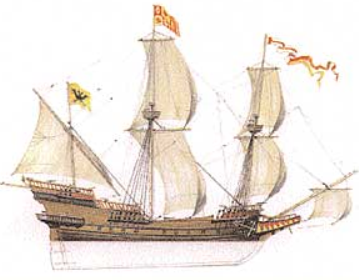Difference between revisions of "Spanish Galleon"
(removed juvenile vandalism) |
(→Stats) |
||
| Line 18: | Line 18: | ||
=Stats= | =Stats= | ||
* Crew - 30-400 men (average - 200) | * Crew - 30-400 men (average - 200) | ||
| − | * | + | * Passengers - 100 |
* Speed (Knots) - 10 | * Speed (Knots) - 10 | ||
* Max Guns - 40 (20 per broadside) | * Max Guns - 40 (20 per broadside) | ||
| Line 26: | Line 26: | ||
* Length - 210 ft | * Length - 210 ft | ||
* Draft - 30 ft | * Draft - 30 ft | ||
| − | * | + | * Manoeuver - 4 |
Latest revision as of 21:15, 1 December 2020
Description[edit]
High castles fore and aft and multiple decks of guns bring to mind the large galleons with lofty sails and graceful lines that transported the riches of the New World to Spain. Yet, the original galleons used to explore the lands across the oceans rarely surpassed the size of a modern-day offshore fishing boat..
Spain needed seaworthy ships capable of making transoceanic voyages while laden with vast cargoes, but early sea vessels lacked these qualities. Designers borrowed the best characteristics of existing ships to build just such a vessel. From the caravel came the fixed rudder and lateen sails. From the carrack came the sturdy hull and fore and aft castles. The result was the galleon, which combined square and lateen sails rigged on three or four masts with a longer ratio of length to beam and castles more integrated with the structure of the ship.
The internal structure of Spanish galleons included a series of braces, knees, and decks as evidenced in The Fragments of Ancient Shipwrightry by the English shipwright, Matthew Baker. These allowed for more than one deck of guns aboard ships for the first time. The heaviest gun found aboard a galleon was approximately ten feet long and fired shot weighing thirty-two pounds. Yet, the most suitable gun for use on this vessel was the demi-culverin. Some Spanish galleons carried as many as thirty-six guns: sixteen culverins on the lowerdeck, twelve demi-culverins on the upper deck, and eight sakers.
Spain eventually built much larger, more elaborate galleons with the combined purpose of carrying cargo and soldiers. More than two thousand trees--pine, cedar, oak, and mahogany--were required to build the largest of these, some of which became the warships that guarded the flota, or fleet, of vessels bound for Spain from the New World with holds laden with riches. A typical galleon weighed five hundred tons, but the largest were 1,200 tons. The high superstructure, which clearly identified a Spanish galleon, made the ship clumsy and slow. While larger in size, though, life aboard the galleon was no better for mariners than previously designed ships. Wealthy or influential passengers plus their servants could put the total number of people aboard a galleon at two hundred soldiers and sailors and up to fifty civilians, which made for very cramped quarters.
A typical Spanish galleon had a number of decks: forecastle, upper or weatherdeck, main deck, lower or orlop deck, poop deck, and quarterdeck. The crew's quarters were in the bow while the officers and passengers lived in cramped cabins in the waist or center section of the galleon. Provisions were stowed near the galley. Larger galleons also had a surgeon aboard. In addition to the sailors and soldiers that made up the crew, there were also the carpenter, sailmaker, cook, and cooper.
The captain or admiral lived in the Great Cabin, earmarked by large windows, greater space, and more comfort. While his was above deck, the crew slept and ate on the gundecks where it was dark, damp, and odorous. Insects and rats abounded and foodstuffs often spoiled.
The crew of a Spanish galleon with thirty guns might number 180 men. In battle, sixty-six worked the guns, fifty manned small arms on the upper deck, and fifty sailed the ship. Four were stationed in the powder room and as many as four carpenters repaired damage belowdeck. The surgeon commanded several men who served as assistants in tending the wounded. The remaining crew kept watch for fires. Few galleons sank from enemy attacks, though. The enemy's guns more often damaged the rigging and masts, and inflicted serious wounds on the crew from flying splinters when shot crashed through wood.
Stats[edit]
- Crew - 30-400 men (average - 200)
- Passengers - 100
- Speed (Knots) - 10
- Max Guns - 40 (20 per broadside)
- Max gun size - 32 lbs
- Hull Points - 600
- Cargo - 300 ton
- Length - 210 ft
- Draft - 30 ft
- Manoeuver - 4
